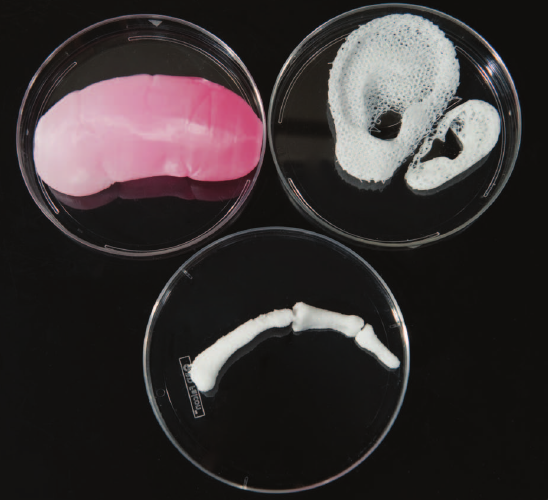The Body Printed
By Shannon Fischer
NOTE: This is an overview of the entire article, which appeared in the November/December 2013 issue of the IEEE Pulse magazine.
Click here to read the entire article.
There are currently 119,000 patients on the organ donor list in the United States alone, dying at a steady rate of 18 per day. Imagine a world in which a person could make a new liver or kidney just by hitting the “print” button. It may seem like science fiction, but a seven-year-old California start-up company, Organovo, is at the forefront of three-dimensional (3D) bioprinting with the ultimate goal of producing printed organs.
Organovo’s bioprinter is manufacturing functional liver tissue, 4-mm wide and 20 cell layers thick, that has all the ingredients of an original organ: tight hexagons of hepatocytes and fatty stellate cells, and endothelial cells gathered into nascent capillaries. The “liver” also produces cholesterol, albumin, and detoxifying P450 enzymes. Once it is printed, the ensemble can survive almost an entire week – nearly triple the endurance of classic 2D liver cultures. This is significant because the longer these multi-cellular tissues can be maintained in the laboratory, the more thoroughly they can be studied for functional and cellular changes.
In spite of these amazing discoveries, there are several major hurdles that must be addressed, such as science’s limited understanding of biological functioning,and the need to provide adequate vascularization to thick tissues. The entire article addresses these issues, along with many examples of progress that has been achieved to date. Because organs vary greatly in their complexity, it will be a while before solid organs can be printed successfully. Body parts such as tracheas and bladders are simpler in design, but a kidney has more than 30 different types of cells, all fed by an elaborate network of channels.
Researchers also must continue to work with experts to create state-of-the-art printers. Marc in het Panhuis, head of the Soft Materials Group at the University of Wollongong, Australia, believes that the next wave of technology will include hybrid printers that combine the best of each technology to print across sizes and speeds. Anthony Atala has already combined the multi-nozzle printer built in his Wake Forest lab with different bioinks to print micro- and macrotissue architecture. He is now using the machine to create kidney prototypes (See Figure below).

A kidney prototype and ear and finger bone scaffolds were printed on a 3-D bioprinter in Atala’s lab. (Photo courtesy of the Wake Forest Institute for Regenerative Medicine.)
This year, Organovo’s microlivers will go on the market, not for transplant, but for drug development. The ability to test the efficacy of proposed drugs on actual human tissues and organs has the potential to save billions on the creation of pharmaceuticals. Organovo has already partnered with various pharmaceutical companies, including Pfizer and United Therapeutics.
Looking ahead in bioprinting technology, David Williams, a manufacturing and regulatory scientist at Loughborough University, United Kingdom, believes it won’t be organs, such as the liver and kidney which will hit the market first, but rather the simpler parts that don’t require much vascularization or different tissue types (like bone). Others predict that cartilage and skin will emerge early on for the same reasons. “It’s something that we’ll have happen in the next generation,” says Williams.
ABOUT THE AUTHOR
Shannon Fischer is a freelance science writer living in Boston, Massachusetts.






